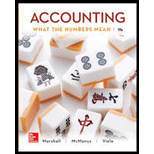
Concept Introduction:
Dividend Dividend is the reward given by the company from its residual profit to its shareholders. It can be in the form of cash or otherwise. It is given by the board of directors only after shareholder's approval through their voting rights. It is not mandatory for a company to declare dividends.
Dividends paid to the shareholders holding preferred stock of the company are termed as preferred dividends . This dividend is given preference over other common shares at the time of dividend distribution. In case of dividends remaining unpaid, dividends would be first paid to this class of shareholders whenever they are paid.
In case of cumulative shares if the dividend remains unpaid, that dividend amount is kept on cumulating over the years for which the dividend remains unpaid. In the event of dividend distribution, the cumulative dividend is also paid along with the regular dividend.
Requirement 1:
To calculate:
Semi- annual cash dividend to be paid on 9% cumulative
Concept Introduction:
Dividend Dividend is the reward given by the company from its residual profit to its shareholders. It can be in the form of cash or otherwise. It is given by the board of directors only after shareholder's approval through their voting rights. It is not mandatory for a company to declare dividends.
Dividends paid to the shareholders holding preferred stock of the company are termed as preferred dividends . This dividend is given preference over other common shares at the time of dividend distribution. In case of dividends remaining unpaid, dividends would be first paid to this class of shareholders whenever they are paid.
In case of cumulative shares if the dividend remains unpaid, that dividend amount is kept on cumulating over the years for which the dividend remains unpaid. In the event of dividend distribution, the cumulative dividend is also paid along with the regular dividend.
Requirement 2:
To calculate:
Cash dividend to be paid on cumulative preferred shares
Concept Introduction:
Dividend Dividend is the reward given by the company from its residual profit to its shareholders. It can be in the form of cash or otherwise. It is given by the board of directors only after shareholder's approval through their voting rights. It is not mandatory for a company to declare dividends.
Dividends paid to the shareholders holding preferred stock of the company are termed as preferred dividends . This dividend is given preference over other common shares at the time of dividend distribution. In case of dividends remaining unpaid, dividends would be first paid to this class of shareholders whenever they are paid.
In case of cumulative shares if the dividend remains unpaid, that dividend amount is kept on cumulating over the years for which the dividend remains unpaid. In the event of dividend distribution, the cumulative dividend is also paid along with the regular dividend.
Requirement 3:
To calculate:
Quarterly cash dividend to be paid on 6.5% cumulative preferred shares
Want to see the full answer?
Check out a sample textbook solution
Chapter 8 Solutions
Accounting: What the Numbers Mean
- I am trying to find the accurate solution to this general accounting problem with appropriate explanations.arrow_forwardCan you help me solve this general accounting problem with the correct methodology?arrow_forwardCompany W reported FIFO ending inventory of $152,600 and beginning inventory of $138,500 for 2022.arrow_forward
- Can you show me the correct approach to solve this financial accounting problem using suitable standards?arrow_forwardI need guidance with this general accounting problem using the right accounting principles.arrow_forwardPlease provide the correct answer to this general accounting problem using accurate calculations.arrow_forward
- Please provide the solution to this general accounting question using proper accounting principles.arrow_forwardXenta Products has a contribution margin ratio of 40%. The company's break-even point is 75,000 units, and the selling price of its only product is $6.25 per unit. What are the company's fixed expenses?arrow_forwardI need help solving this general accounting question with the proper methodology.arrow_forward

 AccountingAccountingISBN:9781337272094Author:WARREN, Carl S., Reeve, James M., Duchac, Jonathan E.Publisher:Cengage Learning,
AccountingAccountingISBN:9781337272094Author:WARREN, Carl S., Reeve, James M., Duchac, Jonathan E.Publisher:Cengage Learning, Accounting Information SystemsAccountingISBN:9781337619202Author:Hall, James A.Publisher:Cengage Learning,
Accounting Information SystemsAccountingISBN:9781337619202Author:Hall, James A.Publisher:Cengage Learning, Horngren's Cost Accounting: A Managerial Emphasis...AccountingISBN:9780134475585Author:Srikant M. Datar, Madhav V. RajanPublisher:PEARSON
Horngren's Cost Accounting: A Managerial Emphasis...AccountingISBN:9780134475585Author:Srikant M. Datar, Madhav V. RajanPublisher:PEARSON Intermediate AccountingAccountingISBN:9781259722660Author:J. David Spiceland, Mark W. Nelson, Wayne M ThomasPublisher:McGraw-Hill Education
Intermediate AccountingAccountingISBN:9781259722660Author:J. David Spiceland, Mark W. Nelson, Wayne M ThomasPublisher:McGraw-Hill Education Financial and Managerial AccountingAccountingISBN:9781259726705Author:John J Wild, Ken W. Shaw, Barbara Chiappetta Fundamental Accounting PrinciplesPublisher:McGraw-Hill Education
Financial and Managerial AccountingAccountingISBN:9781259726705Author:John J Wild, Ken W. Shaw, Barbara Chiappetta Fundamental Accounting PrinciplesPublisher:McGraw-Hill Education





